Sounds like a fun day out. Apart from the yellow light of death!
Any early theories on whats killing them ( heat ? )
Sounds like a fun day out. Apart from the yellow light of death!
Any early theories on whats killing them ( heat ? )
ECUMaster claim they only ever really hear about “regular” failures from the Lotus crowd, but then again they denied any other reports completely until I collected a small group of people from the community who all had issues and we presented our stories together… so it could be a software thing.
Bosch sensors are used in just about every form of motorsport and I find it hard to believe that a mildly breathed on 2zz is pushing the boundaries of what it can do heat wise.
2bular manifolds are the other commonality with the Lotus guys who have killed sensors… but good luck having a constructive conversation about that!
Maybe it is heat and the Lotus engine bay area is collecting too much of it, even if I do find it hard to believe. I could maybe go for a “grill-less” rear next year and see if it fares any better, but with between 2-9 months between failures it’s going to be hard to be scientific!
Only other thing Lotus specific is maybe something around condensation or even vibration due to the size/shape of the exhaust.
Without more data it’s hard to say, still relatively few people running aftermarket ECUs on them and even fewer still are doing 8+ trackdays per year plus a load of road miles with regular cold starts etc. It’s annoying though!
Lol!!! ![]()
Oh, and FWIW, 9k rpm 2zz here, 2bular manifold, original wideband lambda still working that RRR fitted ![]()
I should have said hello, I was there (Hethel) for a last drive in my Caterham (the white one). I had never been to Hethel circuit before, I agree with your comments, the site and catering are good.
The circuit was mostly empty, I think I saw you a couple of times on the other side of the loops.
“ the CEL only flashed up under heavy braking or high-G right hand turns… Investigation to follow.”
Might be a rubbish idea, but that sounds almost like it’s related to the brake master cylinder fluid level sensor? My warning flickers on/off under those conditions if it’s not topped up REALLY high?
Ah bugger, we should be holding signs up with forum names above our heads! Yep track was deserted, very rarely had another car in sight - good to have the circuit to yourself, but occasionally I did wonder if I’d been ignorantly circling around through red flags or something ![]()
The CEL is definitely related to the wideband sensor as the ECU is telling me as such, but it does suggest that perhaps there’s something loose. I’ve not had the car apart yet since I got home, but I’m half expecting to see something touching something it shouldn’t be…
My fluid reservoir also does the same, I fill it way past “full” to prevent it.
Do you have the enable at 0 RPM selected? I’ve heard the 4.9’s are very sensitive to moisture. The 2bular exhaust may also be collecting condensation due how the u-bend sits lower than the muffler, at least that is how mine looks.
Also care to share your idle improvement settings? I’m working on that a bit right now and some guidance would be helpful.
The probe is setup for the ‘conservative’ heat up strategy which doesn’t fire it up until 40ish seconds into running the car and then in the EGO Feedback settings its set to a 10s warmup and not to be active below 600rpm, but I think that’s just the feedback loop rather than the sensor itself being active?
I have heard the same about the 4.9 being delicate so this is probably a lead theory. I spoke to another tuner who doesn’t work with Lotus stuff, but does with with EMU’s and LSU4.9s a lot and he’s found in some applications that he needed to wire it into a relay and have the ECU only trigger the relay after an artificial delay - but then there are also concerns with not having the element heated up when the car is running too. It feels like a tightrope, and I’d happily compromise with a less responsive but more robust setup now I think.
As for the idle, it was a culmination of very small tweaks. I found the car was relying too much on the ECU to correct/compensate for the idle target when I first picked it up, and the more you lean in the PID tuned responses the more opportunity you have of ending up with something feeling a bit awkward, so my process was roughly as follows:
Then get the fuelling a bit closer, if needed:
Despite all this, the Lotus inlet architecture will still struggle to ‘catch’ falling revs, so you need to then look at your settings for Virtual Target in the Idle settings. The closer your fuelling/idle tuning is, the less work this mechanism will need to do but my settings are:
Virtual Target Max: 400rpm
Ramp down: 50rpm/sec
My DC Correction settings also have a delay of 1500ms, I think that could maybe be tweaked a bit too for the better. If you set it to 0ms, it can yoyo a bit too much during sharp throttle changes.
The final area which I’ve not really explored yet are the DBW Characteristics, I’ve spoken with a few people who have smoothed this out by doing that - but at the expense of losing a bit of throttle response.
If you want to compare maps, feel free to DM me an email address.
Probably can’t blame heat, vibration, condensation or ECUMaster for this one…
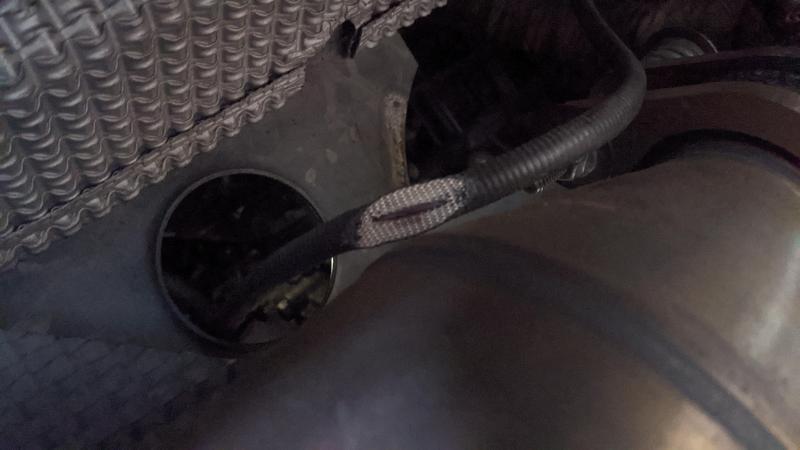
![]()
Though I imagine the wiring is an easy repair job, I’d already ordered a new lambda probe so the old one can go in a box to be fixed another day.
Getting genuine Bosch sensors is not as easy as it sounds, but a general rule of thumb is to consider anything <£100 as a fake, even if it’s listed by a reputable company. This one from Opie passes all of the authenticity checks, so fingers crossed.
The factory probe is held onto the subframe by some little clips. I’d re-used these and they’ve evidently gone AWOL. To give myself a bit more confidence, I added a rivnutted p-clip to the heatshield for the engine mount and hopefully this will prevent any future problems.
Before doing the swap, I used the opportunity of having a legit failure to work on my dash a little bit and created an error for this. This is in addition to the traditional engine warning light, but gives a bit more detail so if it throws up on track again when doing big RPM at high speed, I don’t panic quite so much.
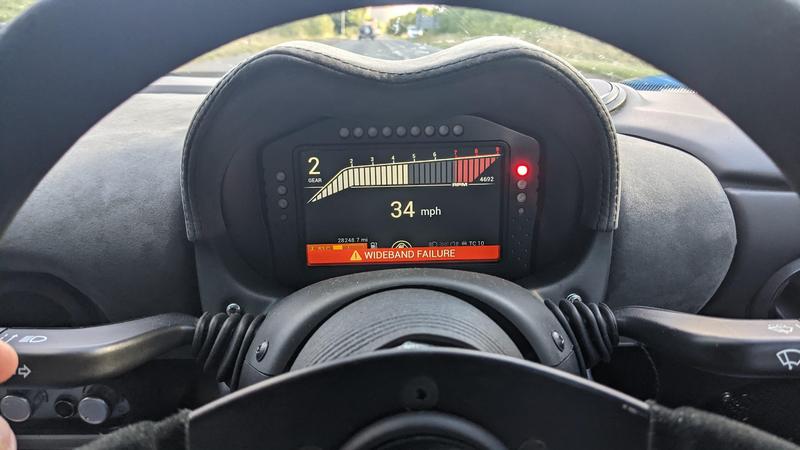
Probe all swapped over and working now, but seems I now have a puncture. Fun never ends.
Anglesey Update
After the biblical conditions of my Anglesey trackday earlier in the year, I wanted another stab at it. I really love the circuit, but hadn’t come close to ‘leaning’ on it yet. This was supposed to be my maiden voyage towing my Exige with the new Volvo V90 daily, but it all got a bit cocked up. I had my B&E towing test booked for September, but then mid-month the Govt’ abolished the certification to free up resource for new HGV drivers. The certification and hence my training/test was cancelled immediately but the law change that would allow me to tow without it doesn’t come into force until Nov 15th. How annoying.
Anyway, the missus kindly offered to make a weekend of it and follow me over in the Volvo anyway which meant I could take spare tyres, tools, etc. We stopped over with a friend in Snowdonia the night before and arrived at the circuit to find yet more biblical weather :lol:
I started the day out on my “road setup”, AD08RS tyres and very soft damping. The car felt pretty grippy to be honest, weak front end but loads of traction even when getting a little bit abusive with the throttle.
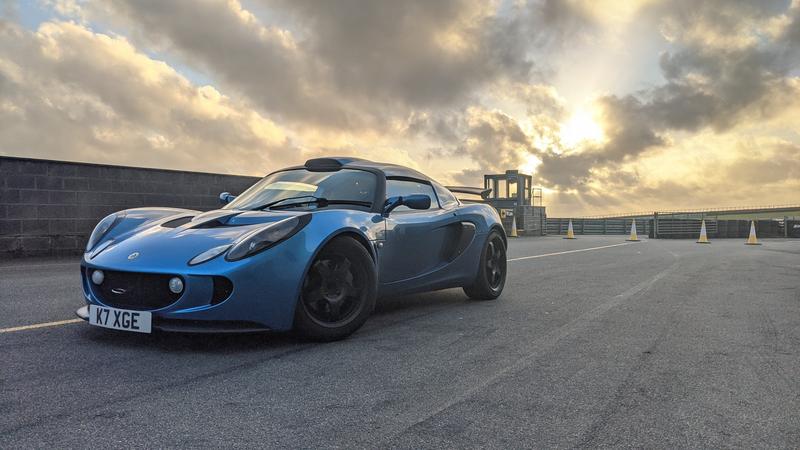
Coming down from the positivity of Anglesey, I think I’m going to take my gearbox out again.
This isn’t a new issue, but since mid summer I’ve noticed that my gearbox is getting noisier and noisier when coasting. Any load at all will make the sound go away, as will dipping the clutch but it happens in all gears (not just the new ones I had fitted) which makes me think it’s differential/final drive.
I think I posted about it at the time, but my one regret from my gearbox rebuild last winter was sticking in a differential that I found on eBay with no real history. It came with the two bearings already pressed on and even though I urged the rebuild place to put new ones on, I don’t believe they did and as a result I’m convinced that they’re on their way out.
All 2zz/C64 boxes are a bit noisy when coasting, both of my Lotus cars have been but I can’t help thinking it’s getting worse and I’ve got some expensive parts inside that gearbox now, so I’d like to protect the investment.
I’m still thinking about it, but I think I just want to get on. If it turns out to be a complete waste of time and money then that’s on me, but I’ll hate myself if it fails next year during track season and it takes out some of my fancy cogs with it.
For the reasons outlined above, I got my car up on the ramp and started mentally preparing myself to take the gearbox out again. It’s really not a bad job, just time consuming and not something I wanted to be doing again so soon.
With the car up in the air, I had a good waggle around of everything and found a fair bit of play in the crossgate shift linkage. Grabbing it and giving a shake gave a very metallic rattle, could this be the cause of my noise rather than something internal to the box?!
Luckily it’s pretty accessible, so took the offending parts off the car and had a look.
At the end of the crossgate lever is a large round pin, this goes into a plastic bush which “converts it” to a rectangular shape where it then sits in a slot on the shift rod itself coming out of the gearbox. This plastic bush slides in the slot during gear changes, and the circular pin rotates within the bush too - so it’s got an opportunity to wear from both directions.
Bad photo, but you can see metal on metal contact at the 12 and 6 oclock position on the pin where the zinc plating has worn off.
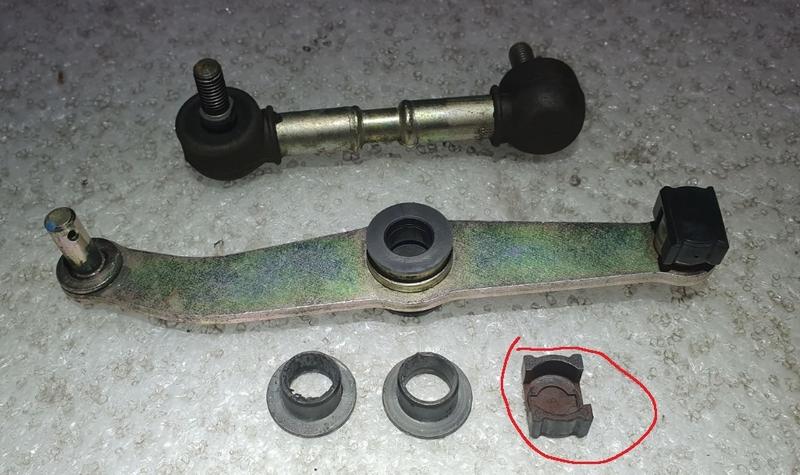
Luckily these parts seem to be available from toyota for not a lot of money, but I wanted a way to try and test the theory to decide whether or not the box would still be coming out. I took the pin and covered it with some heatshrink to pad out the ‘slop’ in the bush.
I can’t see this lasting more than a few gear changes, but hopefully it would last long enough for me to see if the rattle had subsided.
Bolted it back up followed by a quick test drive… and it’s a LOT quieter. There’s no perceptible rattle anymore in 1, 2, 5 or 6. 3 and 4 have a slight soundtrack on overrun but it’s not a rattle and I suspect it’s more the semi-helical nature of the stronger gears I have in those slots. It’s not unpleasant, it’s not worrying and I don’t think anyone would notice it if their senses weren’t on overdrive.
For now I’m relieved, maybe “carefully optimistic” is a good term but I won’t be rushing to drop the box out anytime soon after this discovery. I’ll refurbish the linkage with new bushes, and I may consider some of the gucci billet linkage options that the US community seem to love. It replaces a few of the plastic/metal interfaces with proper bearings and rosejoints etc although annoyingly the round:square bush that I’ve found here is still part of that setup.
That freed up some motivation to get cracking on with a small pile of parts I’ve been sitting on for most of the year. I’ve been modifying my car so far to give as much reliability and longevity as possible but other than gaining a few ponies from the ECU and remap, I’ve not pushed power on at all despite having a platform now that I think/hope can take a bit more.
The car doesn’t need to be any faster, on track it’s got a lovely balance of grip to power where it still feels like I can lean on it and be a bit clumsy without it biting me… but I can’t shake the feeling that there’s some untapped potential in it.
First up, injectors. I can see my current 440cc injectors are getting close to max duty and can’t keep up with any more boost. I’d been wanting some specific injectors for a while from Injector Dynamics but UK supply was just not available. When my fuel pump had an issue in the summer I bought some FiveO motorsport injectors to rule out an injector issue, but never ended up using them - so they got sold on. I then got in touch with a Lotus owner in the US who had bought some of the ID injectors and found them too small(!) for his build, so he kindly shipped them over to me.
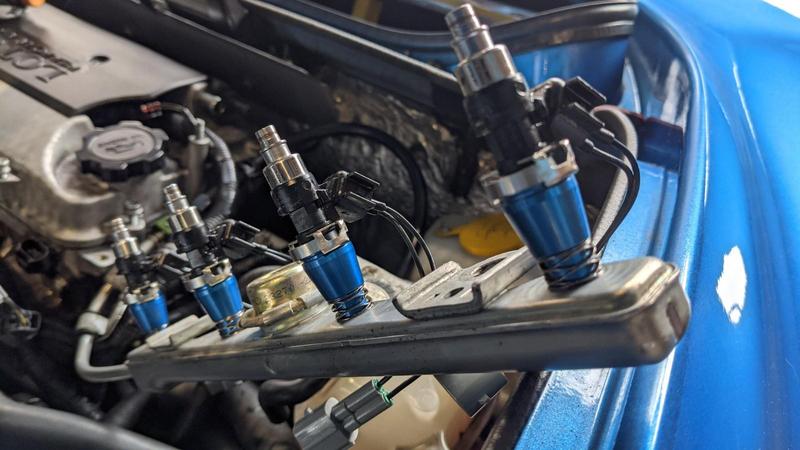
They’re ID XDS1050s, massively over gunned for what I need but they’re now the smallest that ID make because they’re so confident in their low load pulse control, they found the 750’s they used to do are now redundant. I’m a big fan of ID injectors since tinkering with my Subaru, it’s amazing what difference a quality set of injectors with real and accurate data can make to the low load driveability of a tweaked car - so hoping for the same from these.
Along with fitting the injectors, I’ve revised the fuel rail plumbing a little bit. Earlier in summer my fuel pump had a partial failure which meant I was running on only 1 bar of fuel pressure, enough to limp home but the engine/ECU had no way of knowing about the fault. The ECUMaster ECU has fuel pressure compensation strategies available, so by adding a fuel pressure sensor I can both inform myself of any future issues but also increase my odds of limping the car home safely if needed.
The least intrusive way of adding a 1/8npt takeoff for a sensor was to replace the flexible fuel hose that connects the rail to the hard line going to the pump. By converting to AN-6 fittings, it opens up a world of adaptors and fittings to make it work. I robbed the idea from an off-the-shelf replacement pipe from Radium Engineering, but I needed a slight alteration due to my catch cans blocking the route.
The analogue gauge is temporary just to help me calibrate the digital sensor that will replace it.
You can just about make out the pipe run here, plenty of slack to allow for engine movement and nicely circumnavigates the catchcans.
Observant will notice a missing header tank, I barely touched the fkin thing and a take-off snapped off of it. Grrr
Once I get a header tank replacement, I’ll get the car idled and finetuned on the new injectors to at least allow me to limp it to a mapper for a proper setup. Oh, and we’ll need to arrange for some boost increases before that time too, so smaller pulley will be arranged. ![]()
Incredible!
I have a header tank with a makeshift fix here if you need it Kyle.
Cheers Andy, I ebayed a Celica one for a few quid to hopefully get me by. If it’s ropey I might consider a fancy one.
Wee bit of progress, while I had the chargecooler off and a few other bits out of the way I whipped my cam cover off for what’s turning into an annual check of lobe wear and valve clearances. All still within spec, happy days.
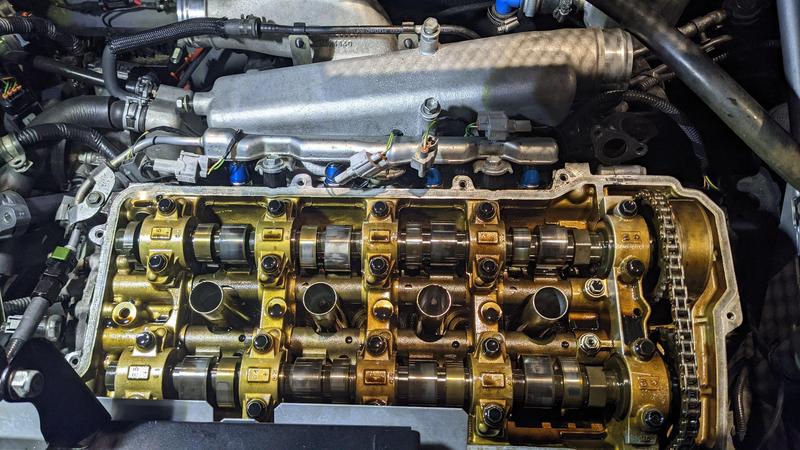
That then gave me an opportunity to swap for a blinged up cam cover that was kindly donated to the project by a project that will remain nameless involving a cup car that had loads of effort piled into it to never actually get used. Which was red.
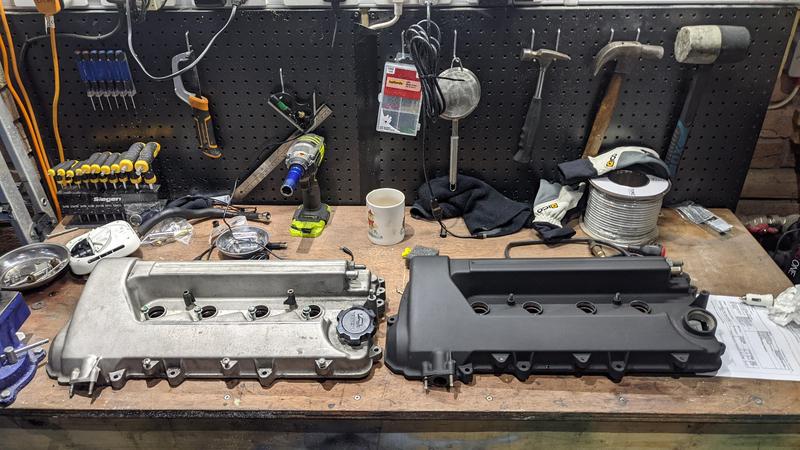
Fitted some new seals/gaskets to that and gave it a good clean out - blowing some oil through the cam squirter lines and make sure it was all flowing freely and without dust.
My Toyota replacement header tank was next to arrive, was in better nick than the eBay photos suggested it would be and it cleaned up a treat.
Looks like it’s been subject to much less UV abuse than mine
Then was the new bushes for my crossgate linkage. This has definitely tightened things up a bit, but you can still feel where the rocking motion comes from as the parts are just not in tight enough tolerance. I’ll see if this is enough to fix/hide my coasting rattle but I fear I’m already falling down the rabbit hole of linkage upgrades. We’ll see.
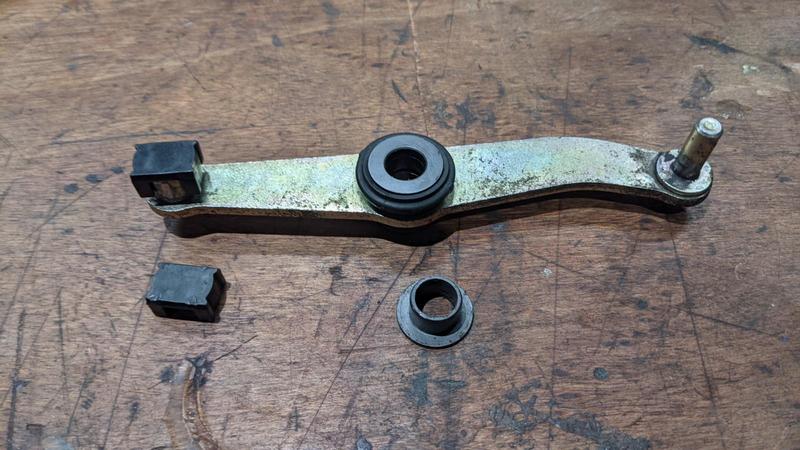
With everything buttoned back up, I then had the job of making sure the car would run on the new injectors. It’s a pretty dry topic but I’ve been enjoying learning. Oh, and I fitted Lambda sensor #5 ![]()
The EMU fuelling model allows for setting up the injector parameters with fuel pressure compensations/corrections which means that the underlying fuelling VE table can be mapped independently of fuel hardware changes (in theory). Because my car went to RRR with unknown injectors and since the 2ZZ has no pressure sensor from factory, they were limited to what they could do here - so all of the work was done in the VE table. Nothing wrong with that, car obviously has been running fine but you can get a more accurate picture of things if you add in a fuel pressure sensor and set things up ‘properly’, which is what I intend to do.
The 2ZZ operates a dead head fuel rail so there’s no rising rate FPR like I’m used to from faffing around with Subarus. It makes things a little more complex to get my little head around, but effectively the base pressure (4bar in my case) will either be assisted by manifold pressure in vacuum (so effective pressure goes up a bit during idle) or is pushed back by boost pressure, so the effective pressure drops during “pulls”. Using some injector flow data comparisons provided by ID, you can then map in a correction table to compensate for this so that your fuelling will always be “right” and your VE table setup regardless of conditions. If you then had a fuel pump issue which was reducing your base fuel pressure (such as the issue I had at Blyton earlier in the year) then the ECU would know about this, could throw a warning and stick the car into limp mode whilst compensating the fuelling - allowing me to limp home with a safe level of AFR.
In the real world it’ll make very little difference, but it’s just another case of me having functionality from the standalone ECU - so I want to use it.
So far I’ve just got it idling right and everything has gone to plan. Car fires right up and idles bang on AFR target. I still need to finalise the wiring for my pressure sensor as it’s bodged in at the moment, so I’ll sort that this week then I can go out and make sure the corrections are working with a bit of load on the system.
I Still intend to get it mapped properly on a dyno, but hoping I can get myself 90% of the way there with the tools I have at my disposal.
Great work as always Kyle - you never mentioned much of this while some others we know are dismantling their cars - all great stuff to see getting the car to where you want it. Was really impressed seeing all of your work coming together at Anglesey - easy to think with the detail you share that its just small bits, but you’ve made a great package with all your changes, and built a stunning car.
I was really impressed by your build and your driving development - and it just worked through the day rather than falling apart and limping home
I used it, just not much, but technically it was used…
Overdue an update, lots of boring tinkering involving the fuel pressure sensor and the DIY map tweaks to get it running alright at low load/cruise. Summary is, pressure sensor is now in and reporting to the ECU which means the ECU now has a reading of what the effective fuel pressure is across the injectors (baseline fuel pressure - manifold pressure). I even made a wire.
The only real advantage of this is error checking, if I have a problem with fuel pressure now (such as I did at Blyton last year), the ECU will notify me of this (along with a soft RPM limit to limp me home) and it will also over compensate at the injector to make sure my limp home still is fuelling the car healthily. In theory the fuelling calculations would happen a bit more efficiently too, but that’s never going to be noticeable by anything measurable. It also changes the ‘shape’ of the VE Table considerably, as it no longer needs to add fuel as part of the table as manifold pressure goes up, it looks less like a hill and more like a plateau.
With all this extra fuelling capacity, I next needed to consume some of it - so on went a 2.9" SC pulley from Seriously Lotus. It’s Seriously Light too, less than half the weight of the original.
I estimated that the pulley would be worth approx. 3psi of extra boost, taking me from 7ish to 10ish. That’s not an insignificant proportion but it’s well considered that the Lotus pulley size is already getting close to the maximum from the blower in terms of diminishing returns. That said, with a capable fuelling system, programmable ECU and critically the chargecooler from Pro Alloy - I thought I had as good a chance as anybody to get some decent results out of it. I’d decided up front that if the gains just weren’t there to be made, or were barely perceptible that I would revert back to stock boost as I was more than happy with it.
Getting hold of a mapper with some dyno time was proving quite difficult, I put a fair bit of work into the map myself to get it into a cruisable state which worked out pretty well. The car got me safely and reliably to Silverstone for an experience day but it was clear to see that any attempt to breath on the throttle was taking my map into uncharted territory.
I had to change cranking fuel too, one of the only parts of the fuelling calculation that’s not proportional to injector size is the cranking fuel - so my new much bigger injectors were just flooding the cylinders on a hot start. Easy fix.
Expecting to cancel my final trackday of the year (Bedford next Monday) and retire the car for a few months until it could be mapped properly, I got an opportunity out of the blue to jump on a mapping session with Chris @ EFI Parts in Runcorn. He was going to map a friends S3 Elise Cup in the early afternoon, and he had time in the late afternoon to take a look at mine. Chris wasn’t really on my radar, but I did know of one other person who had a 2ZZ Lotus mapped there fairly recently and he gave a good impression, so off I went.
The aforementioned S3 Cup car had a factory mounted chargecooler and it struggled for IATs for much of the session, despite it being bloody freezing outside. This gave me something to worry about, would my setup be able to cope with the extra pressure at load? (Spoiler alert, it coped).
I had a long chat with Chris about everything I’d configured and so he spent some time going over my fuel pressure delta corrections etc, and familiarised himself with my map in general. I made explicit effort to not come across as a know-it-all busybody, but I wanted Chris to know what I’d been cocking about with so that he wasn’t building on a dodgy foundation. Generally he seemed happy with my tweaks though, and he was a gent at explaining things as we went along, helping me learn (a lot!) as we went.
Immediately it was clear that my DIY map was fine for cruising, but any attempt to apply load put you into an area of the timing map that wasn’t previously used (because of boost coming in at different levels/times etc) so had I attempted to drive my car hard with “my” map, it would have quickly ended in tears.
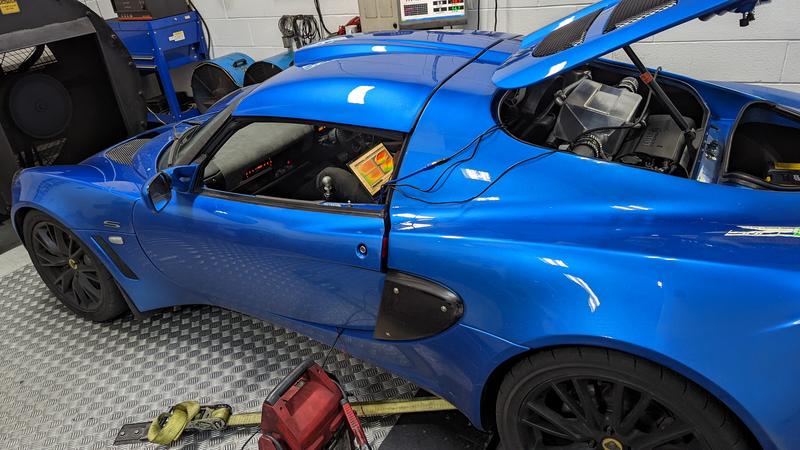
Chris spent some time getting the low lift cam part of the map all dialled in, moving the cam switchover point way up to 6k RPM and only doing pulls up to that point. Played with cam timing a bit, and gave himself a few references as to where power was made, and where it started tailing off so we could pick the optimal point to swing over onto the high lift cam. Early signs that the car would produce a decent number came at this point, when it made 216bhp (flywheel) on the low lift cam at 6k RPM.
Once Chris had a catalogue of low-cam runs to pick from, he reversed the process and brought the cam switch over point in early, to experiment at “that side” of the fence too. With all that done, he could piece together what worked well and where, to come up with the final cam profile. Cam switch has come forward a couple hundred RPM as a result of this, it’s now 4700rpm from 4900rpm.
Power delivery was still lumpy at this point, as I could see from the graphs - so Chris spent the next few pulls smoothing everything out. IATs were bang on, they rose roughly in line with RPMs on the pulls and then recovered to their resting 20degrees-ish within a few seconds. Back to back runs were no problem, and power figures very consistent between runs. How it’ll compare to a 30degree evening at Donington? We’ll find out one day.
With the power runs done, a lot of work was then put in to part throttle and transient conditions - I found this very interesting to watch from the sidelines, as I was aware of a few situations that could “catch out” my previous map, causing it to stumble for a moment. Nothing major, and nothing a lot of people would notice probably - but still it was encouraging to watch Chris try to unpick these scenarios. Acceleration enrichment needed a fair bit of fuel compared to the old map, not sure if that’s an injector characteristic thing or just because the SC spins up so quickly (or both?!).
One of my complaints about this car since the very day I bought it (standard ECU) was the “return to idle”, often it would coast down to a stall when slowing for some lights for example. Adding the ECUMaster ECU “fixed” this to a certain degree, by throwing loads of correction mechanisms at it, but the more you correct it, the clumsier the car would feel at low load due to slow falling RPM and stuff like that. I mentioned this and Chris spent a bit of time going through this too, he pointed out an architectural limitation of my particular setup in that the DBW throttle has a huge area/volume of manifold pressure between it and the inlet manifold itself. Any attempts to correct idle using the DBW throttle results in a latency, so you either have to deal with oscillations - or add enough margin in it to make the car feel slow to respond.
I’m still not entirely sure what Chris did, and how he did it - but he’s essentially pegged the TB to a relatively static level and is using ignition timing to control the fall to idle now, and the results are fantastic. It’s easily the best this car has felt, much better than OE and even my best attempts to tweak it on the previous iterations of my map weren’t quite this good. I’ve had very little time in the car since, and I get the feeling it might need massaging a bit at a few different operating temperatures etc but once I can reverse engineer what he’s done, I feel pretty happy about tweaking this as needed.
I’m sure Chris would have preferred to have the car over night to look at cold start/warmup enrichment stuff, but I had to get off - so we called it a day. I can take care of a lot of the cold start stuff if it needs tweaks, but early impressions look good.
Anyway, onto the figure. The number everyone pretends doesn’t mean anything but secretly it’s all they’re bothered about.
In terms of the number itself, it’s about what can be expected from my hardware. So difficult to get an accurate idea, as there have been some rather optimistic claims made about what this 2ZZ/MP62 setup can achieve over the years - but I think this is about in line.
For reference my previous dyno on standard boost/injectors made 279bhp and 176talks. I always viewed that as the higher end of what the stock system could do, I’ve seen many (many!) maps from various 2ZZ Cars over the last year or so from other community members and my RRR map always jumped out as being fairly aggressive on both fuel and timing. Obviously that never caused me any issues, car took everything I threw at it but since I was now running more boost, this was an opportunity to relax things off a bit.
On the EFI map I’m now running ~11.80 AFR right at the top end (slopes gradually down from around 12.3) and running around 22degrees of advance. On the RRR map it was closer to 12.50 AFR at the top end and 28degrees of advance.
Chris did push the timing a bit more, and we did make a little bit more power - but it was well into diminishing returns and as the car would be used for lots of track time, rather an extra degrees or two of knock margin than 3-4bhp so we pulled it back.
Numbers are one thing, but I wasn’t going to judge success until I could see if it felt appreciably quicker. If it didn’t, I’d go back to standard boost and my old map… borrowing a few of Chris’ idle tweaks along the way. The drive home was freezing and torrential rain, so I barely got above 4k RPM but I finally got some miles on the car in some dry spells this week.
Early impressions are very strong, car undoubtedly feels quicker particularly before cam lift. Feels like there’s an added bit of surge here, and traction has been a bit of a concern as a result. Beyond cam switch, the changeover feels smooth but I’m sure it sounds louder… can’t work that out, maybe I’m just hyper sensitive to all noises/sensations during early testing - but it sounds good.
At the top end the car is ballistic, but then - it was before. It’s definitely quicker and I would easily believe that it’s making an extra 20bhp based on bum dyno. Away from the full throttle pulls, the car feels nicer to drive just about everywhere, responsiveness coming off the throttle is much better, as Chris lowered the fuel cut threshold (I believe RRR kept injectors going at much higher RPM as an attempt to “catch” falling revs due to the aforementioned idle issues).
Provisionally then, I’m happy. Feels like a lot of the work I’ve done to make the car more reliable and able to handle a bit more power is now justified - so hopefully it all works nicely together and I have a good year on track next year. I’m realistically at the limit of what the current hardware can do IMO, bigger/better superchargers are available and the 2ZZ head can/will respond well to a bit of work - but ultimately I’ve always got the gearbox skulking in the shadows.
We discussed the lambda sensor death scenario too. The S3 Elise that went on before me has also killed a bunch of LSU4.9 sensors and has recently switched to an aftermarket controller (still using 4.9’s) to try and rule that out.
Chris was of the opinion that 4.9’s are “fine”, but of all the mainstream sensors they are probably the least robust. He sells and uses himself an external controller from Zeitronix which uses the 4.9 sensors, and his have been fine despite constant abuse on the dyno. If the 4.9 is slightly on the fragile end, and if the ECUMaster onboard controller is working it too hard/fast - maybe that combo is just unhealthy despite both components operating “fine” in isolation.
The EMU will also support the older 4.2 sensor with a bit of rewiring. I’ve heard from a number of sources that this older sensor is more robust, and Chris agrees. But still not on the level of some specific tuner stuff from NTK or whatever.
So with that in mind, it seems like the next logical step is to look at rewiring for an LSU4.2, maybe that’s just enough to live in harmony with the onboard EMU controller. If that fails, I can look at a standalone controller and feed it into the ECU over canbus or whatever.